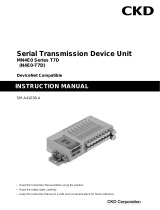
ix
About this Manual:
This manual describes the installation and operation of an DeviceNet Smart Slave Units and includes
the sections described below.
Please read this manual carefully and be sure you understand the information provided before
attempting to install or operate the DeviceNet Smart Slave Units. Be sure to read the precautions
provided in the following section.
The following manuals also cover information related to DeviceNet applications. Use the DeviceNet
Operation Manual together with other required manuals.
Precautions provides general precautions for planning, installing, and operating the DeviceNet DRT2-
series Smart Slaves and related devices.
Section 1 provides an overview of the DeviceNet DRT2-series Smart Slaves, including lists of models,
and information on features that were not included in the DRT1-series Slaves.
Section 2 provides information on hardware aspects of Masters and Slaves connected to a DeviceNet
Network to ensure the proper operation of the system. Included are system configuration examples,
basic procedures for wiring, details on mounting and setting Master and Slave Units, procedures for
connecting cables and power supplies, creating I/O tables, creating and registering scan lists, and
checking operation of the system.
Section 3 provides specifications and indicator displays that are common to all Slaves. The allocation
of remote I/O memory for Smart Slaves is also described here.
Section 4 describes the functions of DRT2-series Smart Slaves and their applications, including oper-
ation procedures using a DeviceNet Configurator.
Section 5 provides the specifications and describes the components, terminal arrangements, basic
procedures for wiring, and methods for connecting cables of General-purpose Slaves. Information on
Slave settings, mounting and wiring methods are also provided separately for each Slave type.
Section 6 provides the specifications and describes the components, terminal arrangements, basic
procedures for wiring, and methods for connecting cables of Environment-resistive Slaves (conforming
to IP67). Information on Slave settings, mounting and wiring methods are also provided separately for
each Slave type.
Manual Contents Cat. No.
DeviceNet
Operation Manual
Describes the configuration and construction of a DeviceNet network,
including installation procedures and specifications for cables, connec-
tors, and other connection devices, as well as information on functions,
operating procedures, and applications.
W267
DeviceNet Masters
Operation Manual
Describes the models, specifications, functions, operating procedures,
and applications of C200HX/HG/HE, CVM1, and CV-series DeviceNet
Master Units.
W379
DeviceNet CS/CJ Series Units
Operation Manual
Describes the models, specifications, functions, operating procedures,
and applications of CS-series and CJ-series DeviceNet Master Units.
W380
DeviceNet DRT2 Series
Slaves Operation Manual (this
manual)
Describes the models, specifications, functions, operating procedures,
and applications of DRT2-series Smart Slave Units.
W404
DeviceNet DRT1 Series
Slaves Operation Manual
Describes the models, specifications, functions, operating procedures,
and applications of DRT1-series Smart Slave Units.
W347
DeviceNet Configurator Ver.
2.@ Operation Manual
Describes the operating procedures of the DeviceNet Configurator. W382
DeviceNet MULTIPLE I/O
TERMINAL Operation Manual
Describes the models, specifications, functions, operating procedures,
and applications of the DeviceNet MULTIPLE I/O TERMINALs.
W348






















